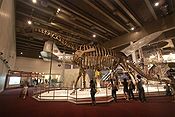
Nurosaurus
Encyclopedia

Nomen nudum
The phrase nomen nudum is a Latin term, meaning "naked name", used in taxonomy...
name for a genus
Genus
In biology, a genus is a low-level taxonomic rank used in the biological classification of living and fossil organisms, which is an example of definition by genus and differentia...
of sauropod dinosaur
Dinosaur
Dinosaurs are a diverse group of animals of the clade and superorder Dinosauria. They were the dominant terrestrial vertebrates for over 160 million years, from the late Triassic period until the end of the Cretaceous , when the Cretaceous–Paleogene extinction event led to the extinction of...
from the Cretaceous
Cretaceous
The Cretaceous , derived from the Latin "creta" , usually abbreviated K for its German translation Kreide , is a geologic period and system from circa to million years ago. In the geologic timescale, the Cretaceous follows the Jurassic period and is followed by the Paleogene period of the...
of Inner Mongolia
Inner Mongolia
Inner Mongolia is an autonomous region of the People's Republic of China, located in the northern region of the country. Inner Mongolia shares an international border with the countries of Mongolia and the Russian Federation...
, China
China
Chinese civilization may refer to:* China for more general discussion of the country.* Chinese culture* Greater China, the transnational community of ethnic Chinese.* History of China* Sinosphere, the area historically affected by Chinese culture...
. It is known from a partial skeleton that has often been seen in traveling exhibitions under various misspellings. "Nurosaurus" had a length of 25 meters (80 ft), and a weight of 22.7 tonnes (25 tons). The proposed binomial name is "Nurosaurus qaganensis" (Dong, 1992).
Location
"Nurosaurus" was one of the largest Chinese long-necked plant eatersHerbivore
Herbivores are organisms that are anatomically and physiologically adapted to eat plant-based foods. Herbivory is a form of consumption in which an organism principally eats autotrophs such as plants, algae and photosynthesizing bacteria. More generally, organisms that feed on autotrophs in...
. It may have been related to the North America
North America
North America is a continent wholly within the Northern Hemisphere and almost wholly within the Western Hemisphere. It is also considered a northern subcontinent of the Americas...
n Camarasaurus
Camarasaurus
Camarasaurus meaning 'chambered lizard', referring to the hollow chambers in its vertebrae was a genus of quadrupedal, herbivorous dinosaurs. It was the most common of the giant sauropods to be found in North America...
. This is seen because "Nurosaurus" has as a similar head and body shape. Photographs also show it had similarly-split neural spines on its back
Dorsum (biology)
In anatomy, the dorsum is the upper side of animals that typically run, fly, or swim in a horizontal position, and the back side of animals that walk upright. In vertebrates the dorsum contains the backbone. The term dorsal refers to anatomical structures that are either situated toward or grow...
vertebrae.
Spelling

Dong Zhiming
Dong Zhiming , from the Institute of Vertebrate Paleontology and Paleoanthropology in Beijing, is one of China's leading paleontologists. He began working at the IVPP in 1962, learning from Yang Zhongjian who was director at the time...
and Li, 1991). The fossil has even traveled under this name under some North American tours. The specific
Species
In biology, a species is one of the basic units of biological classification and a taxonomic rank. A species is often defined as a group of organisms capable of interbreeding and producing fertile offspring. While in many cases this definition is adequate, more precise or differing measures are...
name has been spelled either "qaganensis" or "chaganensis". The official spelling will not be known until it is formally described in a peer-reviewed paper.

